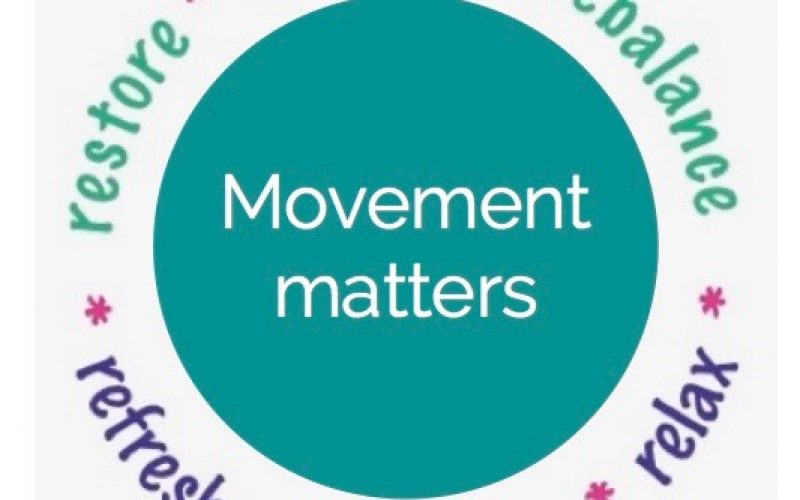Movement matters are the blog section dedicated to getting you moving. Exercise hacks (*) are 5 – 10 minutes offerings of simple home movement or ‘exercise’. Taken from my toolbox of somatic movement, osteopathic practice, Pilates exercise repertoire, personal and clients favourites.
* Life hacks refer to shortcut or methods that increase productivity and efficiency, our exercise hacks are designed to do the same, or just make you feel great.
Health and safety:
While you are working without the guidance of a teacher home exercise is your responsibility. Do not attempt these if you are in acute pain, and stop if you feel discomfort, dizzy or experience pain.
Exercises list
- Pelvic Curls
- Knee Circles
- Toe Taps
- Oyster
- 4-Point Kneeling Hip Hinge
- Monkey Bend/ Pilates Squat
Preparation; starting positions
Relaxation position or semi-supine lying
- For comfort use an exercise mat or folded blanket.
- Lie on your back with knees bent, and feet flat on the floor hip distance apart.
- The spine should be in neutral if this is comfortable
- Support your head with a cushion, folded towel or similar; your neck should feel relaxed and lengthened at the back.
- Arms by your side or resting gently on your lower ribs
Side-lying starting position
- Lie on your side with knees bend and stacking shoulders, hips, knees, and ankles.
- Lengthen your arm underneath your head and in line with your spine.
- Place other your hand on the mat in front of your ribcage and bend your elbow to help lightly support your position.
- Tip: Double up your mat if needed. When balancing on the smaller surface area of your side, the trunk stabilisers and hip muscles are challenged. Lie against a sofa or wall if you need help with the position.
4 four point kneeling
- Start on your hands and knees, with the heel of the hands under shoulder joints keeping the arms long at the elbows without locking, allowing the wrists to flex. Knees directly under hips and feet relaxed
Comfort tips
Knees – try kneeling on a cushion.
Wrists – support with a rolled up towel or make a fist and rest on knuckles maintaining neutral wrist alignment
Mini Pelvic Curls – Spine Curl
Starting position: Relaxation position, see above
Stage 1
- Exhale gently roll the pelvis so that the tailbone lifts a little and the lower back moves towards the floor with pushing. Stay in your comfort zone and focus on the bones that are moving.
- Inhale and hold this position.
- Exhale as you slowly return to the starting position Inhale and pause
- Repeat 5 times
Stage 2
- While exhaling, curl/move and then lift tailbone and pelvis upwards ceiling, continue to raise the pelvis and spine from the floor. Plant both feet firmly on the floor to ensure that both hips remain symmetrical.
- While inhaling, hold the top position.
- While exhaling, roll back down, starting from the shoulders, keep both feet firmly on the floor
- Repeat 5 times
Watchpoints
- Press the feet into the mat, keep the knees facing forward.
- Think of gently drawing the ischial tuberosities towards the pubic bone and the pubic bone towards the umbilicus.


Knee Circles
Starting position: Relaxation position, see above
- Breathing is relaxed and natural throughout
- Fold one knee up with a relaxed leg. Draw a small smooth, controlled circle, the thigh moves towards the midline of the body and continues to circle the thigh around and back up to the starting position.
- Keep the circles close to the body without changing the position of the pelvis
- Repeat 5 times in each direction, then swap to the other side
Watchpoints
- Maintain a stable and neutral pelvis, and spine throughout.
- The supporting leg should remain still, grounded but without tension.

Toe Taps
Starting position: Relaxation position, see above
- Fold knees up one at a time into a double knee fold, 90-degree if possible (aka chair position) The legs are folded as far as neutral pelvis can be maintained.
- The shin bones should be parallel to the floor, and the legs are hip-width apart. Ankles are relaxed or plantar flexed.
- Inhale.: Relax
- Exhale; Slowly lower one foot and the leg to “tap” the floor. Keep the 90-degree bend in the knee as you lower.
- Inhale: Return the leg to the start and keep the 90-degree bend in the knee as you return the leg.
- Exhale; Repeat with the other leg.
- Repeat 5 times each side
Watchpoints
- Maintain a neutral pelvis and spine throughout.

Oyster
Starting position: Side lying, see above
- Inhale: Relax
- Exhale: Lift the top knee, the leg rotates in the hip-joint as it lifts the knee, and the feet remain together.
- Encourage a full range of movement at the hip-joint without compromising the stable the position of the pelvis. Focus on lateral rotation rather than simply abducting (lifting) the leg.
- Inhale: Return the leg to the starting position.
- Repeat 5 times each side
Watchpoints
- Ensure that the movement is initiated from the hip joint and not from the knee.
- Keep the waist lengthened away from the shoulder.

4-Point Kneeling Hip Hinge
Starting position: 4 four-point kneeling, see above
- Exhale: Hinge the hips to move the body backward, keeping the arms long and straight arms allowing the shoulders and wrists to flex. Only move as far as you can keeping the spine and pelvis in neutral. It’s a small rock backward and forwards
- Inhale: Hinge back to starting position with changing the position of the pelvis or lumbar spine
- Repeat 5 times
Watchpoints
- Maintain spinal curves, do not arch or flatten the back
- Hinge at the hips, keep the elbows and back straight throughout
- Try not to push through your shoulders
- Keep head and face in the same alignment, nose, and eyebrows looking at the floor.


Pilates squats
The squat is considered by many as one of the fundamentals of all exercise and a crucial functional movement in daily life, yet it is executed poorly by many people. The ability to squat correctly is key to avoiding many knees, hip and back problems, and one of the movements that give people independence. A well-executed squat is a full body exercise.
Starting position standing see above.
- Exhale: Drive the hips back to bend the knees, allow the ankle to soften, maintain tripod of support the base of the big toe, the little toe and the heel. Aim to get low enough to sit on a sofa.
- Inhale: As the hips flex the torso will naturally tilt forwards slightly.
- Exhale: Straighten the legs and return to the starting position.
- Repeat 5 times
Watchpoints
- Keep the weight evenly balanced through both feet, by maintaining tripod support.

Final tips:
Practice 2 -5 times a week to see and feel the best results, but any extra mindful movement is another step towards taking better care of yourself.
SaveSave
SaveSave







